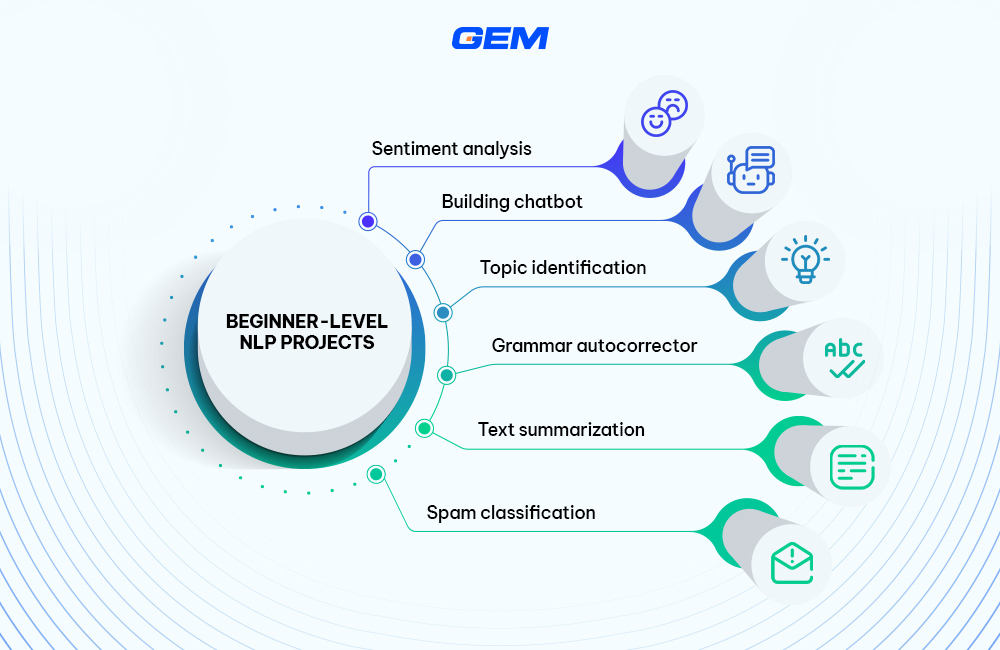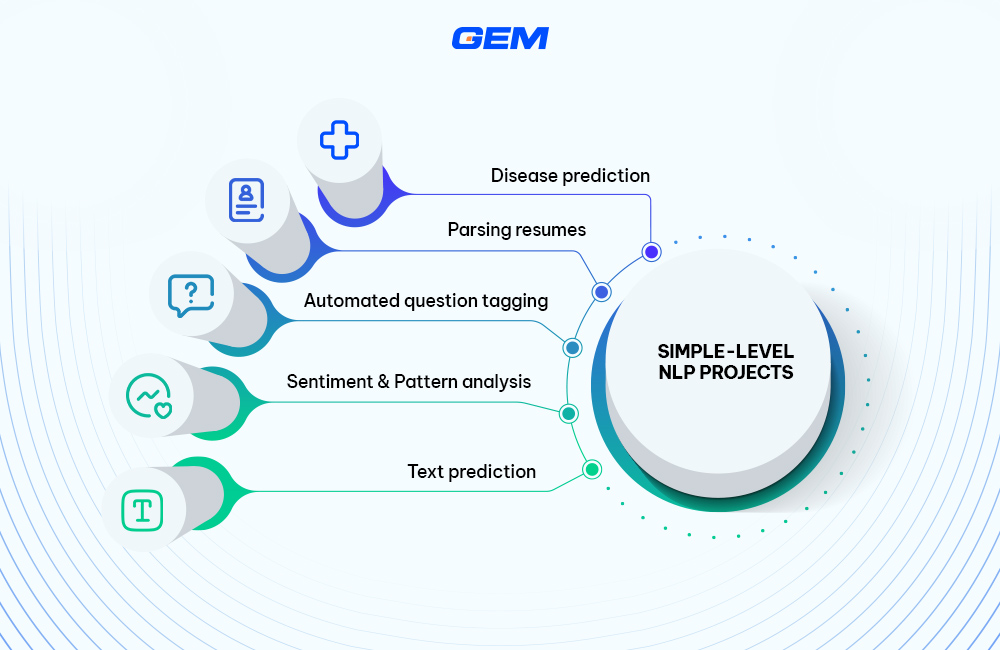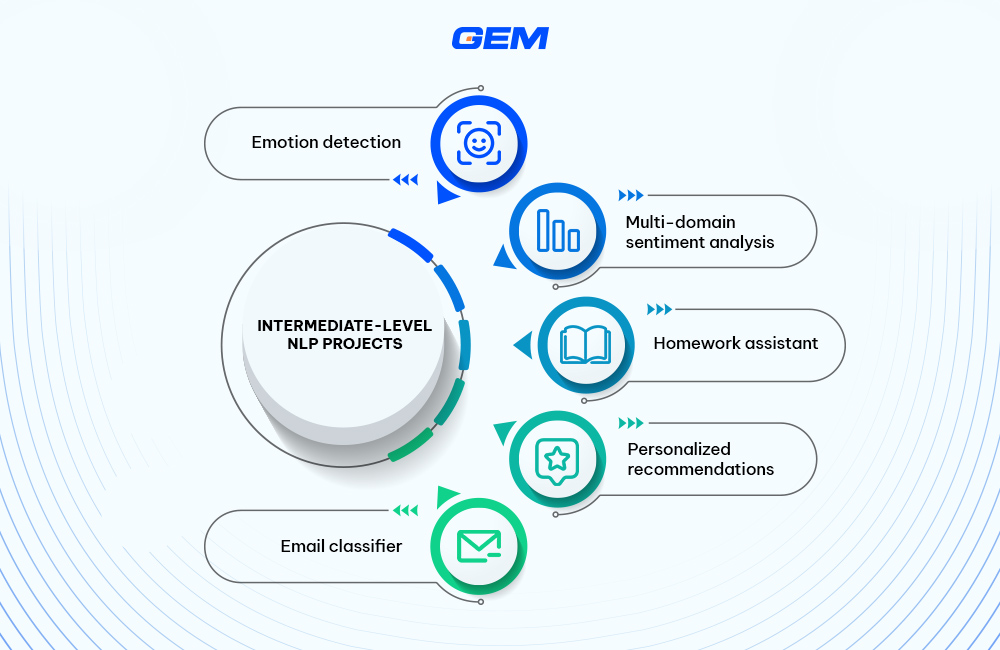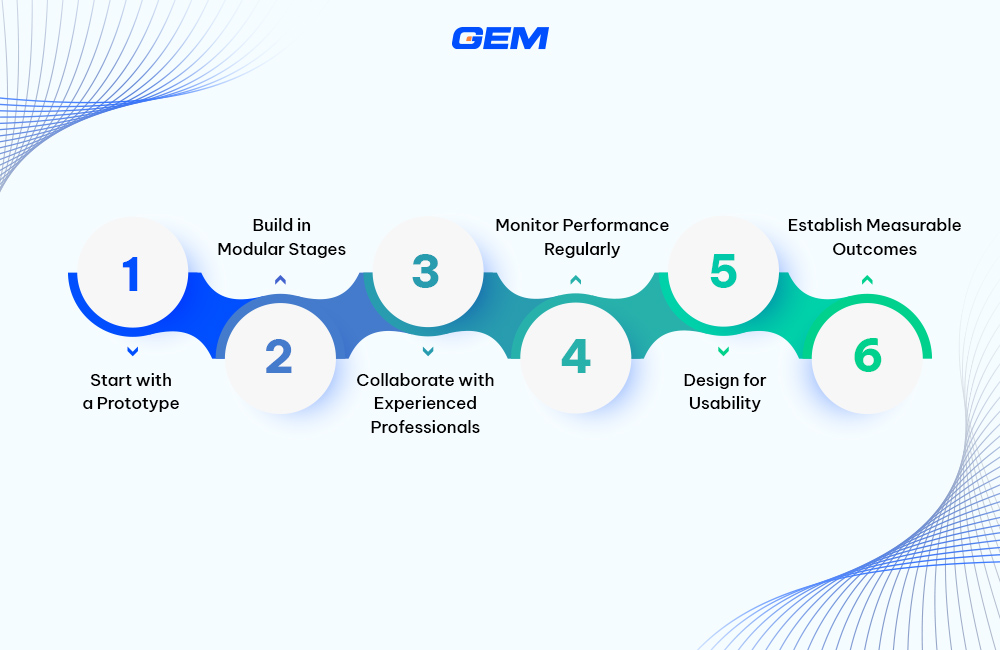Contents
- The Power of Natural Language Processing for Businesses
- Top 35 Natural Language Processing (NLP) Projects
- Are Inefficiencies Draining Your Resources? Let’s Fix That!
- Transform Your Business with the Power of Technology
- Bring your ideas to life faster than ever before
- Find the AI Solution That Fits Your Business Perfectly
- Time Is Money – Stop Wasting Both
- Make your digital transformationseamless and future-ready
- The Strategic Approach to Choosing and Implementing NLP Projects
- Conclusion
Natural Language Processing (NLP) has reshaped how businesses process and analyze data, driving smarter strategies and improved automation. This article presents 35 NLP projects, categorized by difficulty levels, offering a comprehensive guide for decision-makers to identify relevant opportunities. From beginner level to advanced, these projects highlight the potential of NLP in addressing complex business challenges.
Continue reading to explore actionable strategies for implementing NLP initiatives effectively.
The Power of Natural Language Processing for Businesses
Natural Language Processing (NLP), a specialized branch of artificial intelligence, focuses on the interaction between computers and human language. Converting unstructured data, such as customer feedback, emails, and social media content, into structured insights empowers organizations to derive actionable outcomes. This capability has positioned NLP as a strategic asset in modernizing business operations and driving competitive advantage.
Key Business Impacts of NLP
With the global NLP market size estimated to grow to $68.1 billion by 2028 (source: MarketsandMarkets), its applications span industries such as healthcare, finance, and retail.
The integration of NLP into business strategies has unlocked measurable benefits across multiple domains.
Streamlining Operational Workflows
Manual processes such as document sorting, text analysis, and sentiment evaluation have traditionally consumed significant time and resources. When NLP and other advanced technologies step in, they automate these tasks with precision, so teams can focus on high-impact work. This not only accelerates workflows but also optimizes resource allocation, particularly in industries like finance, healthcare, and retail.
Elevating Customer Engagement
The world is moving to hyper-personalization to engage with customers on a deeper level. NLP-driven tools like virtual assistants and chatbots are transforming customer interactions. These solutions go beyond scripted responses, offering dynamic, context-aware conversations that resonate with users – we are talking about predicting their next moves to exceed expectations. For businesses, this means fostering trust, improving satisfaction, and building loyalty, across all touchpoints, in other words – an omnichannel experience.
Extracting Strategic Insights
Big data is great, but what comes with it is organizations are often inundated with vast amounts of unstructured data, from client feedback to market analysis reports. NLP deciphers these inputs, uncovering trends, preferences, and actionable insights that guide decision-making. Those who are able to leverage NLP for data analysis are better equipped to adapt to shifting market demands – an ace for dominating the industry.
Expanding Accessibility to a Global Audience
The globalization of business demands solutions that bridge language and cultural divides. NLP-powered tools, such as real-time translation and speech recognition, pave the way for seamless communication across regions. This fosters inclusivity, enhances collaboration, and opens new opportunities in untapped markets.
Adapting to Changing Business Needs
As organizations evolve, their data ecosystems become increasingly complex. If legacy systems run into data handling issues, then NLP systems are built to manage rising volumes and diverse formats of data in the most efficient way, providing stability and flexibility that support long-term growth.
Top 35 Natural Language Processing (NLP) Projects
This comprehensive list of 35 NLP projects provides opportunities to explore various applications of natural language processing, ranging from foundational concepts to cutting-edge innovations that address real-world challenges.
Beginner-Level NLP Projects

These projects are designed for those new to NLP, introducing fundamental techniques and concepts through straightforward implementations that build a solid foundation.
1 – Sentiment Analysis to Decode Customer Opinions
Businesses leverage sentiment analysis to assess customer feedback and identify patterns in public perception. This approach uses natural language processing to classify feedback into categories like positive, neutral, or negative, offering valuable insights for decision-making. Through advanced techniques, organizations can also explore emotional subtleties, such as frustration or satisfaction, to better understand customer behavior.
Process
The process begins with exploratory data analysis (EDA) to uncover trends within textual datasets. Preprocessing steps include cleaning data by removing irrelevant information, normalizing text, and focusing on relevant keywords or phrases. Once prepared, algorithms analyze the data to classify sentiment and provide measurable insights.
Key Techniques
- Lexicon-Based Methods: Tools like VADER analyze sentiment using predefined word dictionaries and scores.
- Machine Learning Models: Algorithms such as logistic regression or Naive Bayes generate more accurate classifications by learning from data patterns.
- TF-IDF (Term Frequency-Inverse Document Frequency): This method identifies key terms that influence sentiment classification by measuring their importance within a dataset.
- Markov Chains and Feature Engineering: These techniques refine sentiment predictions by modeling text sequences and relationships between words.
Applications
- E-Commerce: Platforms analyze product reviews to discover common themes, adjust inventory, or create personalized recommendations.
- Marketing Campaigns: Real-time analysis of social media sentiment allows businesses to track campaign performance and adjust strategies accordingly.
- Customer Experience: Monitoring customer feedback helps organizations address recurring issues and improve satisfaction metrics.
Dataset Suggestion
Datasets like IMDb Reviews or Twitter Sentiment Analysis provide practical examples for testing sentiment analysis techniques and applying them in real-world scenarios.
2 – Building a Chatbot with NLTK
Chatbots provide automated responses based on user inquiries, reducing repetitive tasks. This project demonstrates how to preprocess text, classify inputs, and create logical replies. These systems address routine queries while managing more complex tasks through structured escalation processes.
Process
The chatbot development process begins with text preprocessing, a critical step where raw text is cleaned, tokenized, and normalized. Techniques like lemmatization and Parts-of-Speech (POS) tagging ensure the text data is ready for classification. Using Python’s NLTK library, developers train the chatbot to categorize user inputs and generate appropriate responses.
Key Techniques
- Bag-of-Words Model: A foundational approach for text representation, used to identify word frequency patterns in the chatbot’s dataset.
- Naive Bayes Classifier: Commonly used for text classification tasks, this model helps the chatbot determine the intent behind user messages.
- Advanced Models: For a more dynamic chatbot, explore Sequence-to-Sequence (Seq2Seq) models and transformer-based architectures like GPT for context-aware responses.
Applications
- Customer Support: Automated handling of repetitive inquiries, reducing wait times and improving user experience.
- E-Commerce: Guiding users through product selections, offering recommendations, and assisting with order tracking.
- Healthcare: Assisting patients with appointment bookings, symptom checks, and providing first-level support.
Dataset Suggestion
Use open-source datasets like the Cornell Movie-Dialogs Corpus or customer conversation logs to train and test your chatbot.
3 – Topic Identification for Data Labeling
Topic identification analyzes unstructured data to extract key themes and organize content. This approach is particularly valuable for managing large datasets, such as customer reviews or research documents. By grouping similar information, organizations can streamline access to relevant insights and improve data-driven decisions.
Process
Topic identification involves preprocessing text data by cleaning and vectorizing it. Algorithms like Count Vectorizer or TF-IDF convert text into numerical formats suitable for machine learning. Models like Latent Dirichlet Allocation (LDA) or K-Means clustering are then applied to group documents under relevant topics.
Key Techniques
- TF-IDF and Count Vectorizer: Transform textual data into numerical representations for analysis.
- Clustering Algorithms: Use unsupervised methods like K-Means clustering or LDA to group documents by similarity.
- Regex for Data Cleaning: Simplify and standardize text inputs to improve model accuracy.
Applications
- Customer Feedback: Categorize reviews into themes like product quality, pricing, or service delivery to prioritize improvements.
- Market Research: Analyze competitor reports and industry news to identify emerging trends.
- Content Management: Organize large repositories of documents, making them easier to retrieve and analyze.
Dataset Suggestion
The 20 Newsgroups dataset is a commonly used resource for topic modeling projects.
With GEM’s cutting-edge solutions, we’ll help you streamline workflows, optimize operations, and set your business up for sustainable success.Are Inefficiencies Draining Your Resources? Let’s Fix That!
4 – Grammar Autocorrector to Enhance Text Quality
Grammar autocorrectors analyze text to detect and correct grammatical errors. These systems improve the readability of written content by addressing inconsistencies and restructuring sentences. They are valuable tools for professionals, students, and writers aiming to produce polished and accurate work.
Process
Building a grammar autocorrector involves preprocessing, rule-based approaches, and statistical or pre-trained NLP models. Libraries such as spaCy and LanguageTool offer robust spell-checking and grammar correction functionalities. Fine-tuning pre-trained models like GPT or BERT improves accuracy for specific use cases.
Key Techniques
- Spell Checkers: Use libraries like Hunspell or PySpellChecker to identify misspelled words.
- Rule-Based Models: Apply grammar rules to identify errors in sentence structure.
- Pre-Trained Models: Fine-tune GPT or BERT to correct grammatical errors and suggest stylistic improvements.
Applications
- Content Creation: Enhance written content for blogs, reports, or academic papers.
- Real-Time Correction: Integrate autocorrect features into chat applications or text editors.
- Professional Communication: Ensure error-free emails and presentations.
Dataset Suggestion
The C4 200M Grammar Error Correction dataset on Kaggle is an excellent resource for building grammar correction systems.
5 – Automatic Text Summarization for Efficient Information Digestion
Automatic text summarization condenses lengthy content into concise summaries, focusing on the most relevant details. This technique helps users process large volumes of information efficiently, making it easier to identify critical points without reviewing entire documents.
Process
Text summarization techniques can be divided into two types:
- Extractive Summarization: Key sentences are selected directly from the text based on their relevance.
- Abstractive Summarization: A summary is generated by rephrasing and condensing the content using NLP models.
Libraries such as Hugging Face Transformers are particularly effective for implementing these methods. Algorithms like Cosine Similarity rank sentence importance, while pre-trained models like GPT and T5 fine-tune summaries based on specific use cases.
Key Techniques
- Cosine Similarity: Measures the relevance of sentences within a document.
- Hugging Face Transformers: Pre-trained models for both extractive and abstractive summarization tasks.
- Fine-Tuning Models: Train models on domain-specific data to improve accuracy.
Applications
- Legal and Financial Services: Summarize lengthy contracts or reports to highlight key points.
- News Aggregation: Generate concise news briefs for quick consumption.
- Healthcare: Summarize patient records for faster decision-making during consultations.
Dataset Suggestion
The Amazon Fine Food Reviews dataset or CNN/DailyMail dataset offers excellent opportunities for testing summarization techniques.
6 – Spam Classification to Fight Junk Emails
Spam classification identifies and filters irrelevant or harmful emails, separating them from important messages. This process applies classification algorithms to analyze email content and detect spam patterns. It helps reduce exposure to fraudulent messages while improving the prioritization of important communications.
Process
Spam classification begins with collecting email datasets and preprocessing the data by tokenizing, removing stopwords, and vectorizing text. Algorithms like Logistic Regression or LSTM (Long Short-Term Memory) networks are trained to identify patterns associated with spam emails.
Key Techniques
- Text Preprocessing: Tokenize and clean email content to improve model performance.
- TF-IDF and Word Embeddings: Convert text into numerical features for analysis.
- Adversarial Learning: Enhance models to recognize evolving spam patterns and bypass adversarial tactics.
Applications
- Email Providers: Filter spam and phishing emails to improve inbox quality.
- Financial Sector: Prevent fraudulent communications targeting customers.
- Marketing: Identify and remove spam-like promotional emails to protect brand reputation.
Dataset Suggestion
The Email Spam Dataset or Enron Email Dataset provides excellent resources for training and testing spam classification algorithms.
Read more: Explore how GEM’s NLP and AI Chatbot Development services build intelligent chatbots that automate customer interactions and understand user intent.
Simple-Level NLP Projects

Focusing on slightly more structured tasks, these projects help learners apply basic NLP methods while solving practical problems with minimal complexity.
1 – Predictive Text System
Predictive text systems are commonly used in messaging applications to predict and complete text input. This project involves building a similar system that uses foundational and advanced NLP techniques to predict the next word or phrase in a sequence.
Process
The project starts with understanding and implementing the n-gram model in Python, which lays the foundation for analyzing word sequences. For improved performance, models like RNNs (Recurrent Neural Networks), LSTMs (Long Short-Term Memory networks), and encoder-decoder architectures can be applied. Preprocessing steps include cleaning the text data and preparing it for training.
Key Techniques
- N-Gram Model: Analyze word patterns and relationships to predict sequences.
- Recurrent Neural Networks (RNNs): Capture sequential dependencies in text data.
- LSTMs: Address long-term dependencies for better context awareness in text prediction.
Applications
- Messaging Platforms: Enable predictive typing for improved user experience.
- Accessibility Tools: Assist users with disabilities by providing sentence completion.
- Smart Devices: Power virtual assistants to generate contextually relevant responses.
Dataset Suggestion
Datasets such as Penn Treebank or text corpora like Gutenberg can be used to train and test predictive text models.
2 – Text Preprocessing Pipeline
This project involves building a basic text preprocessing pipeline to clean and prepare textual data for further analysis. It helps beginners understand the importance of transforming raw text into a structured format that machine learning models can process effectively.
Process
- Start with standard preprocessing steps like lowercasing, removing punctuation, stopword removal, and tokenization using libraries like NLTK or spaCy.
- Extend the pipeline by including lemmatization or stemming to normalize words.
- Visualize word frequency distributions using tools like Matplotlib or Seaborn to identify patterns in the dataset.
Applications
- Data Preparation: A critical step for any NLP model development.
- Word Frequency Analysis: Useful for understanding text data characteristics in projects like sentiment analysis or text summarization.
- Language Learning Tools: Helps identify common words in documents for educational purposes.
Dataset Suggestion
Use small text datasets such as news articles, product reviews, or publicly available datasets like the SMS Spam Collection.
3 – Keyword Extraction Tool
This project involves creating a simple tool to extract the most relevant keywords from a given text. It is a great way to learn about feature extraction and text ranking techniques in NLP.
Process
- Implement basic statistical methods like TF-IDF (Term Frequency-Inverse Document Frequency) to identify keywords.
- Use Python libraries such as Scikit-learn or spaCy to calculate TF-IDF scores and extract top keywords.
- Enhance the tool by visualizing extracted keywords using a word cloud or bar charts.I
Applications
- SEO Tools: Identify focus keywords for content optimization.
- Research Summaries: Highlight key terms in academic papers or reports.
- Content Tagging: Automate the tagging process for blogs or articles.
Dataset Suggestion
Use short articles, blog posts, or publicly available datasets like the BBC News dataset to test the tool.
Adopt AI, cloud solutions, and advanced analytics to reimagine your operations and stay ahead of the competition. Let’s future-proof your business together.Transform Your Business with the Power of Technology
4 – Basic Sentiment Analysis System
This project focuses on building a simple tool to classify text as positive, negative, or neutral based on its sentiment. It introduces beginners to text classification techniques and the concept of polarity in text.
Process
- Use a labeled dataset like movie reviews or tweets for training.
- Preprocess the text by cleaning and tokenizing it.
- Implement a basic machine learning classifier like Logistic Regression or Naive Bayes using Scikit-learn.
- Evaluate the model using metrics such as accuracy, precision, and recall.
Applications
- Social Media Monitoring: Analyze sentiment in tweets or comments.
- Customer Feedback: Assess customer opinions from reviews or surveys.
- Product Analysis: Gauge public sentiment about a product or service.
Dataset Suggestion
Use datasets like the IMDb Movie Reviews dataset or Twitter Sentiment Analysis dataset.
5 – Analyzing Purchase Patterns for Retail Insights
This project focuses on understanding consumer behavior by analyzing purchasing patterns. Market basket analysis identifies relationships between products frequently bought together, helping businesses optimize product placement and promotions.
Process
Implement algorithms like Apriori and Fp Growth to discover associations between items in transaction datasets. Preprocessing includes cleaning and transforming transaction data for analysis. Statistical methods such as univariate and bivariate analysis are applied to interpret results.
Applications
- Retail Stores: Design effective product placements to increase sales.
- E-Commerce: Optimize cross-selling and bundling strategies.
- Inventory Management: Predict demand for related products.
Dataset Suggestion
Use transactional datasets from platforms like Kaggle or UCI Machine Learning Repository to build and validate the model.
6 – Automated Question Tagging System
Managing large volumes of user-generated content requires efficient categorization. This project involves creating a system to automatically assign relevant tags to questions, improving content organization and discoverability.
Process
The StackSample dataset, containing questions, answers, and tags, is used to train the model. Preprocessing steps include cleaning and tokenizing the text with tools like Pandas. Multi-label classification methods are employed to predict relevant tags. For additional data, web scraping tools like BeautifulSoup can be used to gather information from platforms such as Quora.
Applications
- Q&A Platforms: Improve the organization of user-generated content.
- Customer Support Systems: Categorize customer queries for efficient responses.
- Content Libraries: Automate the tagging process for large datasets.
Dataset Suggestion
The StackSample dataset, along with custom datasets prepared using web scraping techniques, can be used for training.
Read more: Discover how GEM’s AI Agency transforms raw data into intelligent solutions, powering predictive insights, automation, and next-level AI applications for your business.
7 – Parsing Resumes for Recruitment
Resume parsing systems categorize resumes by analyzing their text. This project focuses on building a system that processes resumes to extract key information such as skills, experience, and education.
Process
Start by extracting text from PDF resumes using Optical Character Recognition (OCR) tools. Preprocess the extracted data and convert it into structured formats like JSON-to-spaCy. Machine learning models are then trained to classify resumes based on predefined categories.
Applications
- Recruitment Systems: Automate resume screening to save time.
- Skill Gap Analysis: Identify missing qualifications for targeted hiring.
- HR Workflows: Streamline hiring processes with categorized candidate data.
Dataset Suggestion
Sample resumes from platforms like Kaggle or scraped datasets from job portals can be used for training.
8 – Disease Prediction Using Clinical Data
In the healthcare sector, analyzing clinical notes can offer predictive insights into patient conditions. This project uses NLP to identify symptoms, risk factors, and potential diagnoses from unstructured medical text.
Process
Begin by collecting electronic health records (EHRs) or unstructured clinical notes. Apply preprocessing techniques to extract meaningful features such as symptoms, demographics, and medical history. NLP models are trained to detect patterns indicative of specific conditions.
Applications
- Healthcare Providers: Support medical professionals in identifying conditions.
- Clinical Research: Analyze patient data to uncover trends.
- Patient Care Systems: Develop tools for personalized treatment planning.
Dataset Suggestion
Use clinical datasets such as MIMIC-III or publicly available health records for building and testing the model.
Intermediate-Level NLP Projects

This section includes projects that bridge the gap between beginner and advanced levels, offering challenges that require a mix of theoretical understanding and practical skills.
1- Detecting Languages from Text with Language Identification System
This project involves creating a language identification system capable of recognizing the language in which a text is written. It is particularly useful for applications dealing with multilingual content or for users curious about the origins of a text.
Process
The project uses the Language Detection dataset, which contains text samples paired with their respective languages. Preprocessing steps such as cleaning, tokenization, and normalization prepare the data for analysis. Algorithms like Naive Bayes, Random Forest, or deep learning models can then be trained to predict the correct language.
Applications
- Content Management Systems: Organize multilingual content efficiently.
- Global Platforms: Support language-based personalization for users.
- Educational Tools: Assist users in identifying and learning new languages.
Dataset Suggestion
The Language Detection dataset can be used to implement and test the system.
2 – Context-Aware Email Classifier
This project focuses on building an email classification system that not only categorizes emails into predefined folders (e.g., Promotions, Social, Primary) but also considers the context and tone of the email. For example, an email about an exclusive offer could be categorized as both “Promotions” and “Urgent” if it contains a limited-time deal.
Process
- Use TF-IDF or word embeddings (e.g., Word2Vec or FastText) for feature extraction to capture semantic meaning.
- Train a multi-label classification model (e.g., Logistic Regression, Random Forest, or BERT) to handle overlapping categories efficiently.
- Integrate sentiment analysis to detect the tone and urgency of the email, adding an extra layer of context to the classification.
Applications
- Personal Email Clients: Organize inboxes more intelligently based on user preferences.
- Enterprise Email Systems: Prioritize emails based on urgency and relevance.
- Spam Detection: Enhance spam filters by integrating sentiment and context evaluation.
Dataset Suggestion
Use publicly available datasets such as the Enron Email Dataset or custom datasets collected using email scraping tools (ensuring privacy compliance).
3- Emotion Detection from Speech
This project explores how emotions can be detected from audio recordings of speech. By analyzing vocal features, it identifies emotions such as happiness, sadness, anger, or calmness, assisting in the development of emotion-aware applications.
Process
Using the RAVDESS dataset, which contains audio clips categorized by emotions, the audio files are preprocessed to extract features like pitch, tone, and intensity. Models such as Support Vector Machines (SVM), Random Forest, and neural networks are trained to classify emotions based on these features.
Applications
- Customer Service: Improve responses by detecting customer emotions during conversations.
- Mental Health Tools: Monitor emotional states for therapeutic purposes.
- Interactive Voice Assistants: Make interactions more intuitive and empathetic.
Dataset Suggestion
The RAVDESS dataset provides a diverse and challenging dataset for feature extraction and classification.
Our agile solutions streamline workflows and cut time-to-market, helping you launch innovations quickly and confidently.Bring your ideas to life faster than ever before
4- Image Caption Generator for Describing Visuals Through Text
This project combines image processing and NLP to create a system that generates accurate textual descriptions for images. It bridges the gap between visual and textual information, making it particularly helpful for users with visual impairments.
Process
The system uses image processing techniques to label objects in an image. These labels are then converted into meaningful sentences using NLP models. Deep learning architectures like CNNs (Convolutional Neural Networks) for image labeling and LSTMs for text generation form the backbone of this project.
Applications
- Accessibility Tools: Assist visually impaired users in understanding visual content.
- E-Commerce: Automatically generate product descriptions for images.
- Content Creation: Automate the process of describing visuals in media.
Dataset Suggestion
The Image-Caption-Quality Dataset from Google Research is ideal for implementing this project.
5- Multi-Domain Sentiment Analysis Tool
This project involves building a sentiment analysis system capable of adapting to multiple domains, such as product reviews, movie reviews, and restaurant feedback. Traditional sentiment classifiers often struggle with domain-specific language; this tool aims to address that limitation.
Process
- Start with a domain-adaptive pretraining approach using a transformer model like BERT or RoBERTa. Fine-tune the model on datasets from different domains to enhance its adaptability.
- Train the system on multi-task learning to handle domain-specific terms and sentiment variations across categories.
- Incorporate visualization tools for presenting sentiment trends and key insights.
Applications
- Market Insights: Analyze sentiment trends for diverse industries.
- Brand Management: Track customer sentiment across multiple product lines.
- Digital Marketing: Tailor campaigns based on domain-specific feedback.
Dataset Suggestion
Combine datasets such as IMDb reviews (movie domain), Amazon product reviews (e-commerce domain), and Yelp reviews (restaurant domain) for training.
Read more: Learn how GEM’s Data Warehouse & Data Lake Services streamline data pipelines, migration, and integration for seamless analytics and operations.
6 – Simplifying Learning with Homework Assistance System
This project focuses on creating an NLP-based application to assist students with their homework. It processes academic content to provide meaningful and relevant answers to queries.
Process
The system uses educational datasets, such as NCERT PDFs or similar resources, for training. Text is preprocessed to extract relevant information, which is then used to answer user queries. Machine learning models are employed to match questions with the most appropriate answers.
Applications
- Educational Tools: Simplify complex academic concepts for students.
- Parental Support: Help parents provide accurate guidance for their children’s homework.
- E-Learning Platforms: Enhance learning experiences with immediate query resolution.
Dataset Suggestion
Freely available educational PDFs, such as those from NCERT, provide a reliable source for implementation.
7 – Automated Meeting Action Item Tracker
This project focuses on extracting and tracking action items from meeting transcripts. The tool identifies decisions, responsibilities, and deadlines mentioned during the meeting, providing a structured summary for participants.
Process
- Convert audio to text using speech-to-text tools (e.g., Google Speech-to-Text or Whisper).
- Use dependency parsing and semantic role labeling to identify key entities and relationships (e.g., who is responsible for what task).
- Train a model to classify sentences into categories such as “Decision,” “Action Item,” or “Discussion Point.”
- Integrate a task management API to automatically create and assign tasks based on extracted action items.
Applications
- Corporate Teams: Automate meeting follow-ups to improve accountability.
- Project Management: Enhance clarity on responsibilities and deadlines.
- Remote Work Platforms: Provide structured summaries for distributed teams.
Dataset Suggestion
Use datasets like the AMI Meeting Corpus or generate custom meeting transcripts from organizational recordings.
8 – PDF Question-Answering System to Streamline Information Retrieval
Navigating through lengthy documents like research papers or manuals can be tedious. This project develops a system that allows users to ask questions and receive direct answers from the content of PDFs.
Process
The system splits documents into smaller chunks for analysis and uses retrieval-based approaches to locate relevant sections. A language model then generates accurate answers. Tools like Hugging Face transformers and Gradio interfaces can be employed to create an interactive Q&A system that processes uploaded PDFs in real-time.
Applications
- Research Support: Quickly locate specific information in academic papers.
- Enterprise Tools: Enhance productivity by simplifying access to manual or report content.
- Customer Support: Help users find relevant details in product documentation.
Dataset Suggestion
Custom datasets prepared from research papers, manuals, or reports can be used for testing.
Read more: Discover how GEM’s NLP and AI Chatbot Development turns complex text and documents into intelligent, interactive solutions that streamline learning, meetings, and information retrieval—explore the possibilities now!
9 – Recommendation System to Personalize User Experiences
This project focuses on building a recommendation system powered by NLP techniques and large language models (LLMs). It delivers personalized suggestions based on user inputs and contextual data.
Process
The system combines traditional machine learning techniques with modern LLMs to generate recommendations. Key parameters such as model temperature and output length are optimized to refine the accuracy of suggestions. The project uses real-world datasets to simulate user interactions and improve recommendation quality.
Applications
- E-Commerce: Provide tailored product suggestions to users.
- Content Platforms: Recommend articles, videos, or books based on user preferences.
- Learning Management Systems: Suggest courses or study materials based on user activity.
Dataset Suggestion
E-commerce or user interaction datasets can be used to develop and evaluate the system.
Advanced-Level NLP Projects

These projects explore the capabilities of NLP in depth, utilizing complex techniques and state-of-the-art tools to tackle industry-relevant problems and develop innovative solutions.
1 – Intelligent Financial Assistant Delivering Real-time Insights
This project focuses on creating a multi-agent AI assistant for delivering actionable financial insights. By automating data retrieval, trend analysis, and report generation, the system supports smarter decision-making in stock trading and investment planning.
Process
- Use Phidata to integrate APIs like yfinance for stock data and DuckDuckGo for web-based financial searches.
- Build a workflow with tools like LangChain-Groq and OpenAI models to analyze trends and summarize insights.
- Implement a modular architecture with agents for fetching, analyzing, and compiling data.
Applications
- Stock Trading Platforms: Deliver market updates and trend predictions to users.
- Investment Firms: Automate research processes to optimize portfolio management.
- Personal Finance Tools: Provide individuals with tailored market insights.
Dataset Suggestion
Use publicly available financial datasets and APIs to simulate real-world data retrieval.
2 – AI-Powered Content Strategy Planner
This project automates the creation of SEO-optimized content plans, helping marketers, bloggers, and digital media professionals craft high-performing strategies tailored to their target audiences.
Process
- Use CrewAI and Llama 3 (70B) for generating content outlines, topics, and keyword-rich structures.
- Define audience personas and integrate tools for keyword research and SEO optimization.
- Empower the system to suggest citations and sources, ensuring credibility in the content.
Applications
- Digital Marketing: Streamline campaign planning with automated topic recommendations.
- Content Creation Agencies: Enhance productivity by reducing manual research.
- E-Learning Platforms: Generate structured course content based on target learner needs.
Dataset Suggestion
Use historical blog data, keyword search trends, and SEO analytics to refine the system.
3 – Cybersecurity Intelligence System
This project focuses on automating threat detection and analysis to enhance cybersecurity resilience. A multi-agent AI system monitors real-time threats, identifies vulnerabilities, and recommends mitigation strategies.
Process
- Integrate CrewAI and LangChain-Groq to analyze threat data from APIs like EXA.
- Use agents to fetch, classify, and prioritize cybersecurity information.
- Generate structured reports highlighting vulnerabilities and recommended countermeasures.
Applications
- Security Operation Centers (SOCs): Automate threat monitoring and reporting.
- Enterprise IT Teams: Identify and address vulnerabilities before exploitation.
- Cybersecurity Consulting Firms: Deliver detailed threat intelligence to clients.
Dataset Suggestion
Use threat intelligence feeds from trusted sources or real-time APIs to simulate live environments.
Confused about the right AI approach? Let us help you uncover a solution tailored to your goals and challenges.Find the AI Solution That Fits Your Business Perfectly
4 – AI Customer Support Agent to Handle Structure Query
This project demonstrates the creation of a structured AI agent capable of handling customer support queries with precision. It integrates robust validation to ensure accurate responses, reducing errors and improving reliability.
Process
- Use Pydantic for data validation and pydantic-ai for building dynamic query-handling models.
- Train the system on structured banking scenarios, such as checking account balances or reporting lost cards.
- Establish strict data types and response formats to minimize errors and prevent hallucinations.
Applications
- Banking: Manage routine queries efficiently with minimal human intervention.
- E-Commerce: Automate order tracking and customer inquiries.
- Telecom: Address issues like billing or service disruptions with structured responses.
Dataset Suggestion
Use domain-specific data, such as banking FAQs or customer support logs, to train the model.
5 – Medical Assistant: Personalized Health Insights
This project involves creating an AI-powered medical assistant capable of analyzing real-time health data and providing personalized recommendations.
Process
- Combine CrewAI and LangChain-Groq with APIs like RapidAPI for retrieving health metrics like blood glucose levels.
- Design task-driven agents for data retrieval and health analysis.
- Train the system to deliver recommendations based on user data and medical guidelines.
Applications
- Healthcare Providers: Support remote monitoring and personalized care plans.
- Patient Apps: Provide insights for managing chronic conditions like diabetes.
- Fitness Platforms: Offer tailored health tips based on real-time metrics.
Dataset Suggestion
Use anonymized clinical data or health monitoring datasets for training and testing.
Read more: Seamlessly migrate and engineer your data with GEM’s Data Platform Transformation, ensuring efficiency, scalability, and reliability for your enterprise systems.
6 – Chatbot Using Large Language Models (LLM)
This project explores building an AI chatbot capable of delivering conversational experiences across different platforms. It focuses on leveraging the capabilities of LLMs to handle diverse user queries effectively.
Process
- Implement the Mistral-7B model for conversational capabilities.
- Train the chatbot on domain-specific data to handle customer support scenarios, FAQs, and general inquiries.
- Optimize the system for contextual understanding and dynamic response generation.
Applications
- E-Commerce: Handle pre-sales and post-sales queries seamlessly.
- Virtual Assistants: Provide personalized recommendations and reminders.
- Customer Service: Address routine inquiries to reduce service workloads.
Dataset Suggestion
Use publicly available conversational datasets or domain-specific FAQ logs.
7 – Cryptocurrency Market Analysis System
This project focuses on creating a multi-agent system that provides real-time analysis of cryptocurrency trends.
Process
- Use LangChain for orchestration, Groq for fast inference, and Exa for news search.
- Divide tasks among specialized agents: one identifies user queries, others analyze coin trends and news, and a final agent compiles a summary.
- Train models to interpret crypto trends and deliver actionable insights.
Applications
- Crypto Trading Platforms: Deliver daily market updates and price trend predictions.
- Investment Firms: Automate cryptocurrency research to inform portfolio strategies.
- Crypto Enthusiasts: Provide accessible and digestible market insights.
Dataset Suggestion
Use crypto market data from APIs like CoinMarketCap or Binance.
8 – Personalized Learning Path Generator
This project focuses on creating an NLP-powered system to generate personalized learning paths for students or professionals based on their goals, skills, and areas of improvement. By analyzing user inputs such as career aspirations or academic performance, the system recommends tailored courses, resources, and timelines.
Process
- Use semantic analysis to process user inputs and extract key goals or gaps in knowledge.
- Implement LLMs to match user profiles with an extensive database of learning resources, such as online courses or textbooks.
- Build an adaptive recommendation model that adjusts the learning path based on user progress and feedback.
Applications
- E-Learning Platforms: Offer customized course recommendations to users.
- Corporate Training: Help employees upskill based on organizational requirements.
- Career Counseling: Provide actionable learning paths for career transitions.
Dataset Suggestion
Use datasets from platforms like Coursera, Udemy, or Khan Academy to train the system.
Every minute spent on repetitive tasks is a missed opportunity. Leverage AI now to increase productivity, save resources, and focus on growing your businessTime Is Money – Stop Wasting Both
9 – AI-Powered Policy Review System
This project involves designing a system that automates the review and summarization of lengthy policy documents, such as legal contracts or compliance guidelines. The system identifies key clauses, highlights potential risks, and provides concise summaries for decision-makers.
Process
- Preprocess documents by splitting them into logical sections.
- Use Named Entity Recognition (NER) to extract key entities like dates, clauses, or terms.
- Apply summarization models to condense the document into actionable insights.
- Integrate a risk analysis module to flag ambiguous or critical clauses.
Applications
- Legal Firms: Streamline contract review processes.
- Compliance Teams: Ensure adherence to regulatory requirements.
- Enterprise Risk Management: Identify potential risks in vendor agreements or policies.
Dataset Suggestion
Use datasets of legal contracts or public policy documents, such as those available on LexNLP or other legal text repositories.
10 – Event Extraction from News Articles
This project aims to create a system that extracts and categorizes events from news articles. The system identifies the type of event (e.g., political, economic, or natural disaster), key participants, and relevant details.
Process
- Use NER and dependency parsing to extract entities and their relationships.
- Train a classification model to categorize events into predefined types.
- Implement a timeline generation feature to present events chronologically.
Applications
- Media Monitoring: Track global events in real-time.
- Crisis Management: Identify and respond to incidents like natural disasters.
- Market Analysis: Monitor economic or political events impacting financial markets.
Dataset Suggestion
Use news datasets like GDELT or EventRegistry to train the model.
Read more: Explore GEM’s Generative AI solutions to transform ideas into intelligent content, automate creative workflows, and unlock next-level innovation for your business.
11 – AI-Powered Meeting Summarizer
This project involves building a tool to generate concise summaries of meeting transcripts. It identifies action items, decisions, and key discussion points, helping teams stay aligned and productive.
Process
- Convert audio recordings into text using speech-to-text tools.
- Apply topic modeling to identify the main themes and discussion points.
- Use summarization models to condense the transcript into a structured format, highlighting decisions and action items.
Applications
- Corporate Teams: Streamline meeting follow-ups and task delegation.
- Project Management Tools: Integrate summaries into task tracking systems.
- Remote Work Platforms: Support distributed teams by documenting discussions.
Dataset Suggestion
Use meeting datasets such as the AMI Corpus or custom datasets generated from organizational recordings.
12 – Cultural Sentiment Analysis for Global Brands
This project analyzes customer feedback and online content for cultural sentiment. It helps global brands understand how their products or campaigns are perceived in different regions, enabling more localized and effective strategies.
Process
- Gather user-generated content from platforms like Twitter, Reddit, or product review sites.
- Use sentiment analysis models fine-tuned for regional dialects and cultural context.
- Apply geotagging to map sentiments to specific locations.
Applications
- Marketing Teams: Tailor campaigns to align with regional preferences.
- Brand Reputation Management: Monitor public perception across different markets.
- Product Development: Adapt features or designs based on regional feedback.
Dataset Suggestion
Use datasets from social media platforms or product review sites, focusing on multilingual and location-tagged data.
Accelerate your business growth with zero-disruption modernization services. Maximize the value of your current infrastructure, streamline processes, and cut expenses.Make your digital transformation
seamless and future-ready
The Strategic Approach to Choosing and Implementing NLP Projects
Natural Language Processing (NLP) offers unparalleled opportunities to address operational challenges, automate workflows, and drive innovation across industries. However, selecting the right NLP project and executing it effectively requires careful planning and alignment with organizational priorities.
Fundamental Factors to Consider
Before committing resources to an NLP initiative, several factors must be examined to guide decision-making and maximize the project’s potential.
- Define a Focused Objective
Clearly articulate the problem the project will address, such as automating repetitive tasks, analyzing unstructured data, or improving user interaction systems. A defined scope helps maintain alignment with organizational goals.
- Evaluate Data Readiness
Analyze whether the available data is sufficient, relevant, and of appropriate quality. NLP relies heavily on data, and gaps in its availability or relevance can limit the project’s performance.
- Assess Feasibility
Understand the technical and operational requirements of the project. This includes the complexity of the task, available infrastructure, and the team’s readiness to execute. Addressing these factors early helps avoid unnecessary obstacles during implementation.
- Prioritize Alignment with Business Goals
Projects should reflect broader organizational priorities, such as improving operations or delivering better customer experiences. This alignment ensures that the project has a tangible impact on the business.
- Consider Future Scalability
Choose projects that can adapt to growth or changing requirements. For example, a customer support chatbot should have the flexibility to handle increasing queries or integrate with additional platforms over time.
Implementation Process for NLP Projects

The success of an NLP project depends on a well-defined execution strategy. These best practices can guide the process:
Start with a Prototype
Begin with a limited version of the solution to test its feasibility and impact. This approach provides valuable insights into potential challenges and helps refine the project before broader deployment.
Build in Modular Stages
Implement the project in phases, focusing on specific components first. This method allows teams to address issues incrementally and adapt as needed without disrupting the overall system.
Collaborate with Experienced Professionals
Partnering with an IT provider specializing in AI and NLP can help manage technical complexities and streamline execution. These collaborators bring proven methodologies and frameworks to the table, supporting smooth implementation while reducing the burden on internal teams. Their involvement can also guide on maintaining and scaling the solution as business demands evolve.
Monitor Performance Regularly
Define metrics to track the system’s performance and adapt it as circumstances evolve. Regular evaluation helps maintain relevance and effectiveness over time.
Design for Usability
Keep the end-user in mind during implementation. Whether it’s an internal tool or a public-facing solution, ease of use encourages adoption and maximizes the value of the project.
Establish Measurable Outcomes

Define clear success metrics, such as improved efficiency, cost savings, or user satisfaction. These benchmarks help assess the project’s impact and guide future improvements.
GEM Corporation brings extensive experience in developing custom solutions designed to address a wide range of business challenges. Utilizing advanced technologies such as natural language processing (NLP), big data, artificial intelligence (AI), and automation, we create and implement systems tailored to the specific needs of our clients. Our portfolio features innovative tools, including AI chatbots, predictive analytics engines, and data transformation platforms, all aimed at providing actionable insights and enhancing operational efficiency. By blending technical expertise with a thorough understanding of industry demands, GEM is a trusted partner for organizations seeking impactful technological solutions.
Conclusion
The collection of the top 35 NLP projects provides valuable insights into how natural language processing can be applied to solve practical challenges and drive innovation. Covering a wide range of complexity, these projects cater to learners and professionals alike, offering opportunities to explore foundational techniques and advanced implementations. By focusing on clarity of purpose, data readiness, and thoughtful execution, these projects demonstrate how NLP can address real-world needs.
To explore how NLP projects can address your business challenges, connect with GEM’s team of experts. Visit our website to learn more about our tailored solutions and discuss how we can support your goals.
Which beginner-level NLP projects offer the most immediate value for businesses?
Projects like sentiment analysis and spam classification are practical entry points. They can be deployed quickly and provide tangible outcomes, such as gauging customer satisfaction in reviews or filtering out irrelevant communication. These initiatives help teams validate NLP use cases without extensive technical overhead.
How can intermediate NLP projects support operational efficiency?
Projects like automated meeting action item trackers or context-aware email classifiers help structure internal communication and reduce information loss. They are especially useful in fast-paced environments where teams need to stay aligned and make decisions based on real-time inputs.
What business functions benefit most from advanced NLP solutions?
Functions such as customer service, compliance, and financial analysis can gain measurable advantages. For example, AI-powered policy review tools or intelligent financial assistants help professionals navigate complex datasets and regulatory content without manual parsing, improving both speed and consistency.
What should companies consider before implementing an NLP project?
Key factors include data availability, system interoperability, and the clarity of business objectives. It’s also important to assess whether the problem involves structured or unstructured data and to define success metrics early. A phased implementation approach, supported by cross-functional teams, tends to increase adoption and reduce friction.






